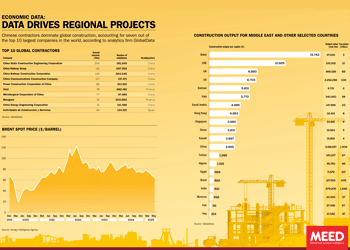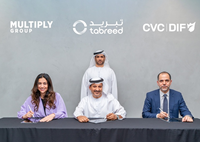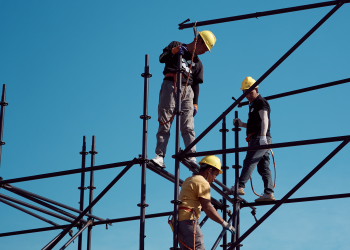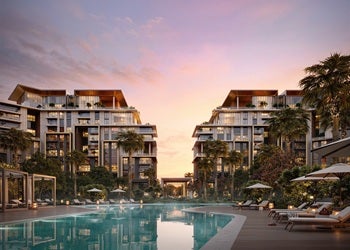Mena water delivers exceptional growth
26 January 2024

Click here for MEED's latest water developer ranking
As a water-scarce hotspot facing geopolitical tensions and climate change, many jurisdictions in the Middle East and North Africa (Mena) region have long recognised that water is an important security concern. It requires sustained investments, especially in light of the region’s long-term economic diversification agendas.
This fact supports the major upturn in spending in 2023, when the total value of awarded contracts within the sector climbed to $20bn – up 74 per cent compared with the $11.5bn-worth of contracts awarded the previous year.
Prior to this, the region awarded the highest value of contracts for a year in 2021, at $14.5bn.
Saudi Arabia registered the largest share, accounting for over 56 per cent, or about $11bn, of the contracts awarded in 2023. This was 69 per cent more than in 2022.
The value of contracts awarded in the UAE, the region’s second-largest market, grew by more than 250 per cent to reach approximately $4.9bn in 2023. This was driven by the awards of three independent water producer (IWP) projects, as well as major water pipeline, sewerage and storm water packages.
All the remaining Mena countries recorded higher values of awarded contracts in 2023 compared to 2022, except for Qatar, which declined by 72 per cent; Jordan, which fell 58 per cent; and Algeria, with a drop of 57 per cent.
Water transmission and distribution network projects continued to represent a significant share of the total awarded contracts, contributing 37 per cent, or $7.7bn, in 2023. This was 1 per cent higher than in the previous year.
A total of $6.8bn-worth of water treatment plant projects was awarded in 2023, in a 180 per cent increase on the value of awarded contracts in 2022. The value of awarded water desalination contracts also grew from $1.8bn to close to $4bn in 2023.
Future opportunities
An estimated $77.5bn-worth of projects across the five Mena water sub-sectors are in the pre-execution phase. This is 29 per cent higher compared to the value of projects on the pipeline a year earlier.
This means that major opportunities remain for both utility developers and engineering, procurement and construction (EPC) contractors looking to win more work within the sector.
As in previous years, Saudi Arabia commands a significant share of future opportunities, with planned and unawarded projects worth close to $30bn. This is expected to grow as the kingdom ramps up capacity to meet its 2030 target to reduce reliance on ground and surface water and enhances its storage capacity – and as the execution of gigaprojects such as Neom gathers pace.
Private utility developers are expected to take a more prominent role as the pipeline of independent water desalination, sewage treatment, water transmission and storage facilities being planned in Saudi Arabia and beyond grows.
This does not preclude growth in EPC projects, with the Saline Water Conversion Company (SWCC) and National Water Company ramping up their procurement activities, and state water offtaker Saudi Water Partnership Company focusing on independent water infrastructure projects.
Beyond the GCC
Last year, Morocco awarded its first major independent water producer (IWP) contract. Spain’s Acciona, in consortium with local firms Afriquia Gaz and Green of Africa, won the $875m contract to develop the Grand Casablanca seawater reverse osmosis (SWRO) plant. The 30-year, build-operate- transfer project will have a design capacity of 548,000 cubic metres a day.
Morocco’s National Office of Electricity & Drinking Water (Onee) is advancing plans for the development of a new IWP following the Grand Casablanca project. To be located in Morocco’s Oriental region, the project will cater to the cities of Nador, Oujda, Berkane, Taourirt and Saidia.
In December, Jordan’s Water & Irrigation Ministry received a single bid for the multibillion-dollar Aqaba-Amman water conveyance and desalination project. If things go as planned, the sole bidder is expected to be awarded the estimated $2bn-$3.5bn contract this year. There is also an expectation that the first batch of Egypt’s planned renewable energy-powered SWRO plants will be tendered over the next 12-24 months.
Sewerage infrastructure
Dubai and Qatar offer some of the most lucrative sewerage tunnel and infrastructure projects over the short to medium term. This year, Qatar’s Public Works Authority (Asghal) is expected to tender four packages of the South of Wakrah and New District of Doha pumping station and outfall scheme. The packages have an estimated value of $1bn-$2bn.
Last year, Dubai Municipality revived its strategic sewerage tunnels project, which is expected to require an investment of up to $22bn. Known as the Deep Tunnels Portfolio, it involves developing assets across Dubai and Hatta.
This includes two sets of deep tunnels terminating at two terminal pump stations located at sewage treatment plants (STPs) in Warsan and Jebel Ali. A conventional sewage and drainage collection system and STPs will be built in Hatta. The scheme also includes recycled water distribution systems connected to the STPs.
For the foreseeable future, water transmission and distribution projects will continue to be a priority in the region. They will remain the largest water sub-sector as utility companies expand their networks to accommodate new residential, commercial and industrial developments; link new desalination and treatment plants to their networks; and replace ageing infrastructure to curb water losses.
Exclusive from Meed
-
 June 2025: Data drives regional projects
June 2025: Data drives regional projects30 June 2025
-
 UAE-Turkiye financial links strengthen
UAE-Turkiye financial links strengthen30 June 2025
-

-
 Iraq approves Basra housing project
Iraq approves Basra housing project30 June 2025
-
 Meraas announces Dubai City Walk expansion
Meraas announces Dubai City Walk expansion30 June 2025
All of this is only 1% of what MEED.com has to offer
Subscribe now and unlock all the 153,671 articles on MEED.com
- All the latest news, data, and market intelligence across MENA at your fingerprints
- First-hand updates and inside information on projects, clients and competitors that matter to you
- 20 years' archive of information, data, and news for you to access at your convenience
- Strategize to succeed and minimise risks with timely analysis of current and future market trends

Related Articles
-
 June 2025: Data drives regional projects
June 2025: Data drives regional projects30 June 2025
Click here to download the PDF
Includes: Top 10 Global Contractors | Brent Spot Price | Construction output
To see previous issues of MEED Business Review, please click herehttps://image.digitalinsightresearch.in/uploads/NewsArticle/14171168/main.gif -
 UAE-Turkiye financial links strengthen
UAE-Turkiye financial links strengthen30 June 2025
 This package on UAE-Turkiye relations also includes:
This package on UAE-Turkiye relations also includes:> UAE-Turkiye trade gains momentum
> Turkiye’s Kalyon goes global

Turkish bank DenizBank is one of Turkiye’s leading private banks and, as a wholly owned subsidiary of Emirates NBD since 2019, it is playing a leading role in developing business links between the UAE and Turkiye.
Recep Bastug, who was appointed as DenizBank’s CEO in 2024, says there is great potential for trade between the two countries.
“Turkiye is a growing country,” he says. “We’ve had volatility over the past five years, but the Turkiye economy and the banking sector have been able to manage those periods successfully.”
Having spent years with international institutions such as BBVA, Bastug has vast experience in the banking sector. “Turkish banks, especially private ones like DenizBank, are very successful. In terms of capital, balance sheet structure and digital transformation, we are in a strong position,” he says.
 Solid fundamentals
Solid fundamentalsTurkiye’s fundamentals remain solid with a diversified export-oriented economy, a young and skilled population of 85 million, and relatively low debt levels. “We are not a highly leveraged country. Our household debt-to-GDP ratio is low. With the right policy mix, we offer high potential for foreign investors,” says Bastug.
That potential is increasingly being realised through growing engagement with the GCC and the UAE. “Turkiye’s connection with the Gulf is going up, and DenizBank is set to play a serious role in these relations. Day by day, Turkish companies are expanding their footprint in the region.”
GCC projects
Baştug says that many of these companies approach DenizBank to help facilitate their entry into Gulf markets. “Some of our clients are extremely well capitalised, but others need support for major projects. Just recently, one Turkish company announced a $3bn project in the region. We’re helping them connect with Emirates NBD and navigate the local financial landscape.”
DenizBank is actively supporting the creation of trilateral partnerships – particularly between Turkiye, the UAE and Saudi Arabia. “We see huge opportunity in forming financial strongholds across these markets, leveraging Turkiye’s contractor experience, the UAE’s capital and Saudi Arabia’s scale,” says Baştug.
DenizBank is already delivering results. “With Emirates NBD, we’ve identified 10 strategic cooperation areas, including trade finance, payments and capital markets. Thanks to this partnership, Emirates NBD has become the number one debt capital markets bank in Turkiye, even ahead of global players.”
One area of growing activity is initial public offering (IPO) participation. “We’ve launched a mutual fund that allows Turkish private banking clients to participate in IPOs from the region, including from the UAE and Saudi Arabia. It’s a diversification strategy and helps retain wealth within the group.”
Turkiye’s connection with the Gulf is going up, and DenizBank is set to play a serious role in these relations. Day by day, Turkish companies are expanding their footprint in the region
Recep Bastug, DenizBankInflation ends
Despite the current inflationary environment, Bastug says there is a clear inflection point ahead. “We expect 2027 to be a turning point. Once we exit the inflationary accounting regime [in Turkiye], DenizBank will become one of the biggest contributors to Emirates NBD’s global balance sheet. Last year, we contributed $1.2bn. In 2027, it will be significantly more.”
DenizBank is the fifth-largest private bank in Turkiye with about a 5% market share. “The largest private bank is at 13%. It’s not easy to close that gap – but we will do it. Our long-term goal, aligned with our shareholder, is to become the biggest and most successful private bank in the country.”
The bank is especially focused on agriculture, SMEs, and export financing – sectors that are deeply relevant to
Turkiye’s economic growth and to regional demand. “We are the leading agricultural bank in Turkiye, and we believe strongly in the sector’s future – both for local consumption and exports.”Regional opportunities
Bastug also sees potential for engagement beyond the GCC, including in post-conflict reconstruction. “In the past, Turkiye had strong trade volumes with Syria. Even during wartime, commercial links remained. Once a stable environment emerges, there will be opportunities – especially in infrastructure.”
While a physical branch presence is not currently being considered, DenizBank is prepared to support Turkish contractors operating in neighbouring countries. “We have the relationships and expertise to facilitate this growth. And culturally, we’re well aligned with the region – it helps make business smoother.”
As Turkiye re-establishes economic momentum and Gulf economies look to deliver on long-term visions, DenizBank is positioning itself for a more active role in the region in the future. “We are preparing the bank for the next stage, and with the backing of Emirates NBD, we’re confident in our ability to lead.”
READ MORE
> UAE-Turkiye trade gains momentum
> Turkiye’s Kalyon goes globalhttps://image.digitalinsightresearch.in/uploads/NewsArticle/14170372/main.gif -
 Multiply agrees to sell Pal Cooling to Tabreed and CVC
Multiply agrees to sell Pal Cooling to Tabreed and CVC30 June 2025
Abu Dhabi-based investment company Multiply Group has agreed to sell all of its shares in its district cooling subsidiary Pal Cooling Holding (PCH) for AED3.8bn ($1bn) to a consortium comprising Engie-backed National Central Cooling Company (Tabreed) and CVC DIF.
The transaction is still subject to regulatory approvals.
MEED exclusively reported in May that a team comprising Tabreed and CVC was holding exclusive discussions to acquire PCH.
Multiply Group initially acquired a 100% stake in PCH and its subsidiaries in July 2021.
Multiply Group has been advised by Standard Chartered and Clifford Chance. Tabreed and CVC DIF have been advised by Citi, Synergy Consulting and White & Case.
The transaction brings together two of the UAE’s leading district cooling players. PCH was founded in 2006 and operates five active district cooling plants across the UAE. The company maintains eight long-term concessions and strategic partnerships with some of the UAE’s leading real estate developers, servicing key residential, commercial and mixed-use developments – most notably on Abu Dhabi’s Reem Island.
Tabreed owns and operates 92 plants, including 76 in the UAE, five in Saudi Arabia, eight in Oman, one in Bahrain, one in India and one in Egypt, in addition to other international projects and operations.
https://image.digitalinsightresearch.in/uploads/NewsArticle/14170511/main.jpg -
 Iraq approves Basra housing project
Iraq approves Basra housing project30 June 2025
Iraq has approved plans to build a housing project in Basra that will offer about 5,000 homes in the first phase to tackle the country’s rising housing shortage.
The project, which is endorsed by Iraq’s National Investment Commission (NIC), will cover an area of about 3 square kilometres.
According to local media reports, Basra province governor Asaad Al-Idani said the project has already been awarded to a developer.
Iraq has been gradually recovering since the war. The government initially prioritised infrastructure and public housing to stimulate economic growth, improve living standards and attract foreign investment.
More recently, benefitting from higher oil prices and a period of relatively stable governance, Baghdad has expanded its focus to reconstructing and modernising the country’s deteriorating infrastructure.
The Iraqi construction market has also seen significant investments from private real estate developers from the region. In May, Egyptian real estate developer Ora Developers announced that it had started construction on the Al-Wardi residential city project, which consists of more than 100,000 residential units covering about 61 million square metres (sq m) on the southeastern side of Baghdad.
The move is the latest sign of international investors’ growing appetite for developing real estate in Iraq as part of the country’s post-war building initiatives.
Also in May, another Egyptian firm, Talaat Moustafa Group Holding, said it was in negotiations with the NIC to develop a mixed-use project. The project, which will cover an area of about 14 million sq m and will be located in the southwest of Baghdad, is expected to contain about 45,000 residential units.
The positive sentiment has been particularly buoyed by a robust 2024 budget, which allocated nearly $42bn to transport, social infrastructure and housing initiatives.
Looking ahead, Iraq’s construction industry is expected to register an annual average growth rate of 4.9% in 2025-28, supported by further investments in energy, infrastructure and housing projects, according to UK analytics firm GlobalData.
MEED’s June 2025 report on Iraq includes:
> COMMENT: Iraq maintains its pace, for now
> GOVERNMENT & ECONOMY: Iraq’s economy faces brewing storm
> OIL & GAS: Iraqi energy project value hits decade-high level
> PIPELINES: Revival of Syrian oil export route could benefit Iraq
> POWER: Iraq power sector turns a page
> CONSTRUCTION: Iraq pours billions into housing and infrastructure projects
> DATABANK: Iraq forecast dips on lower oil priceshttps://image.digitalinsightresearch.in/uploads/NewsArticle/14170011/main.png -
 Meraas announces Dubai City Walk expansion
Meraas announces Dubai City Walk expansion30 June 2025
Register for MEED’s 14-day trial access
Local real estate developer Meraas has announced the City Walk Crestlane project as it continues to expand its City Walk residential community in the Al-Wasl area of Dubai.
The City Walk Crestlane comprises two residential towers offering 198 one-, two-, three-, four- and five-bedroom units.
The project is expected to be completed and handed over by the third quarter of 2028.
Earlier this month, Meraas, which is part of Dubai Holding Real Estate, awarded a construction contract for another project at City Walk.
The local firm Naresco Contracting was awarded a AED450m ($123m) contract for the main construction works on its Central Park Plaza residential project at City Walk.
The project involves constructing two towers with 23 and 20 floors. Together, they will have 212 residential units.
In May, Meraas awarded another local firm, Al-Sahel Contracting Company, a AED300m contract for the main construction works on Elara, which is phase seven of the Madinat Jumeirah Living masterplan in Dubai.
The project involves building three residential towers with 234 apartments.
https://image.digitalinsightresearch.in/uploads/NewsArticle/14169472/main.jpg

